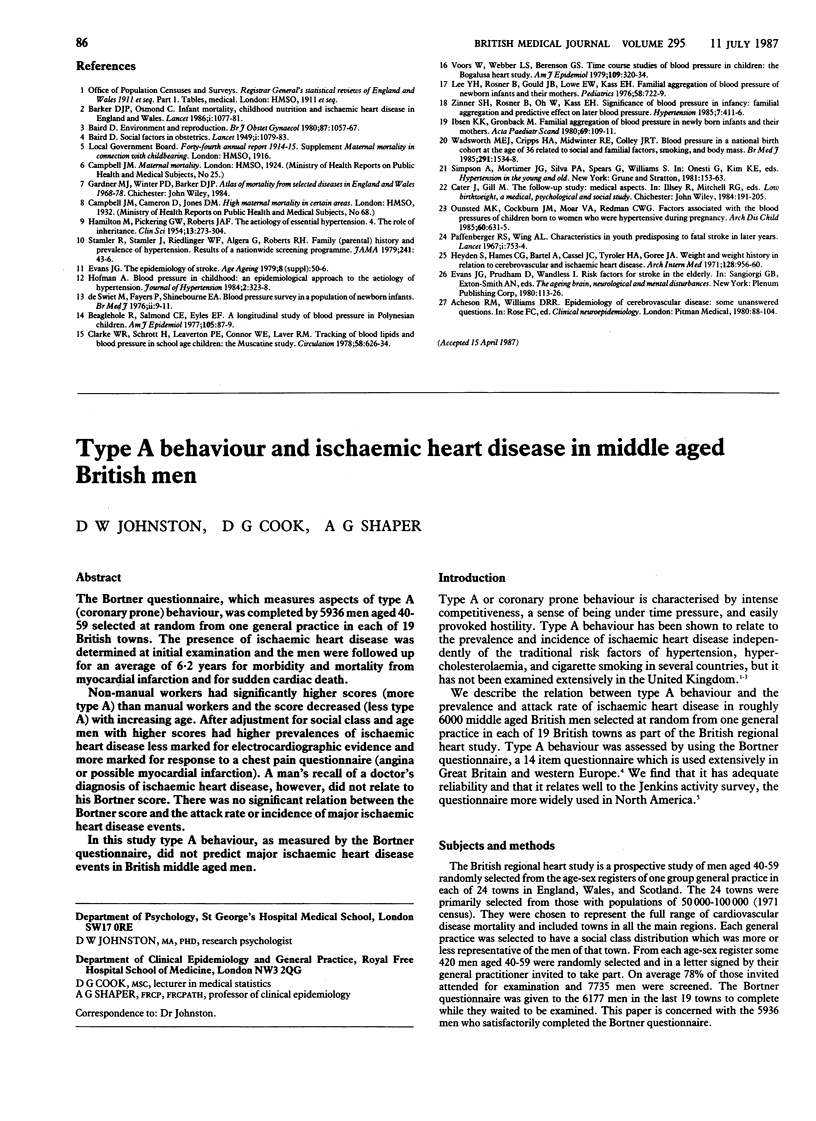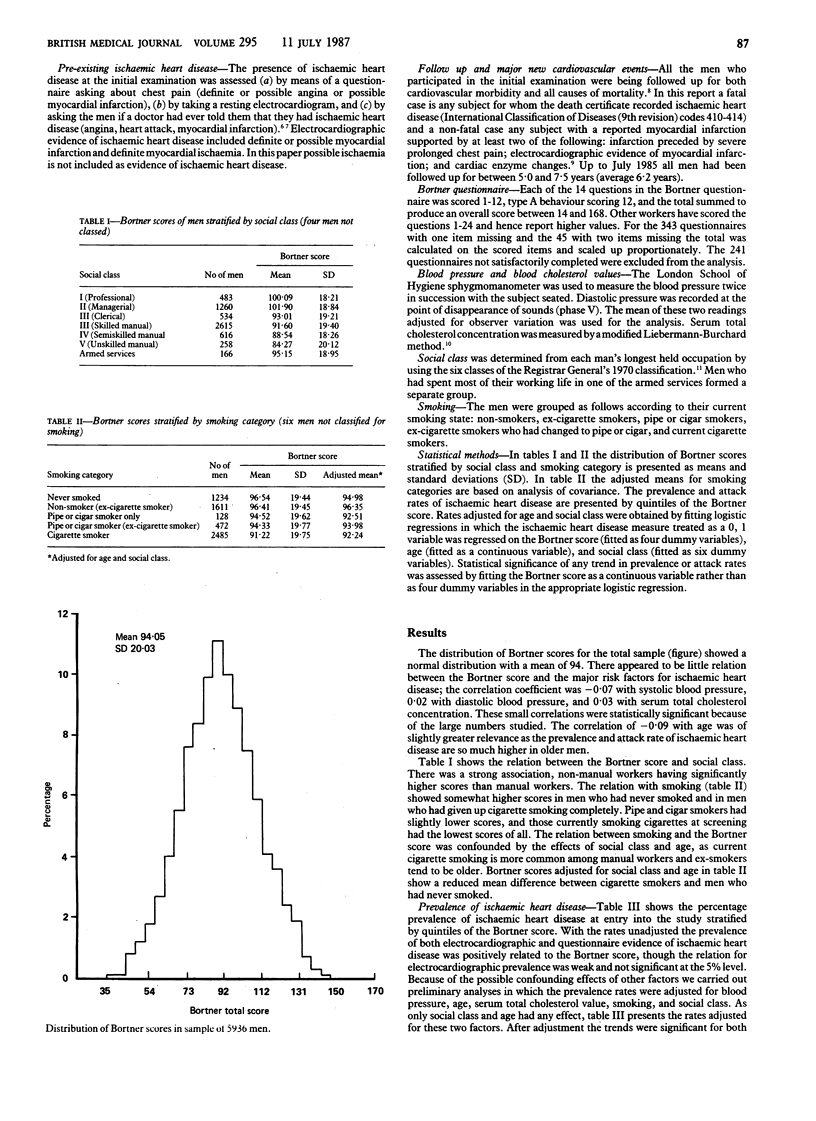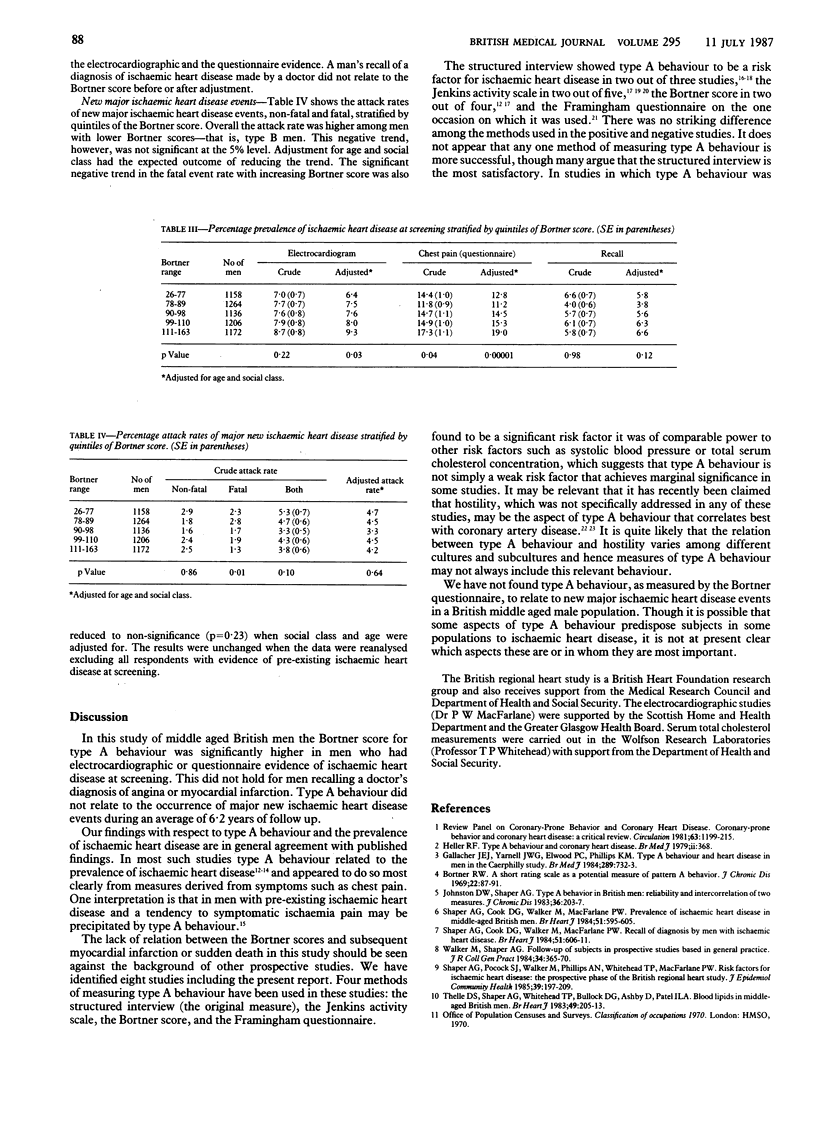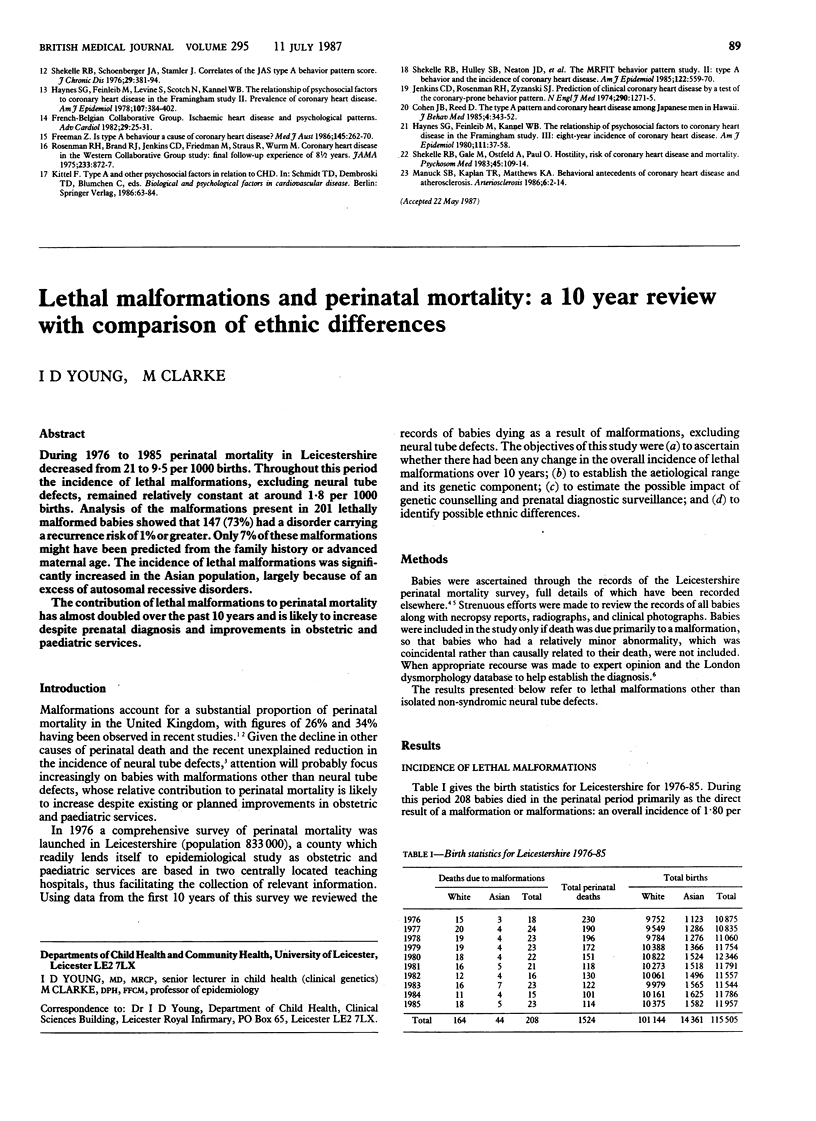Abstract
The Bortner questionnaire, which measures aspects of type A (coronary prone) behaviour was completed by 5936 men aged 40-59 selected at random from one general practice in each of 19 British towns. The presence of ischaemic heart disease was determined at initial examination and the men were followed up for an average of 6.2 years for morbidity and mortality from myocardial infarction and for sudden cardiac death. Non-manual workers had significantly higher scores (more type A) than manual workers and the score decreased (less type A) with increasing age. After adjustment for social class and age men with higher scores had higher prevalences of ischaemic heart disease less marked for electrocardiographic evidence and more marked for response to a chest pain questionnaire (angina or possible myocardial infarction). A man's recall of a doctor's diagnosis of ischaemic heart disease, however, did not relate to his Bortner score. There was no significant relation between the Bortner score and the attack rate or incidence of major ischaemic heart disease events. In this study type A behaviour, as measured by the Bortner questionnaire, did not predict major ischaemic heart disease events in British middle aged men.
Full text
PDF



Selected References
These references are in PubMed. This may not be the complete list of references from this article.
- Cohen J. B., Reed D. The type A behavior pattern and coronary heart disease among Japanese men in Hawaii. J Behav Med. 1985 Dec;8(4):343–352. doi: 10.1007/BF00848368. [DOI] [PubMed] [Google Scholar]
- Gallacher J. E., Yarnell J. W., Elwood P. C., Phillips K. M. Type A behaviour and heart disease prevalent in men in the Caerphilly study. Br Med J (Clin Res Ed) 1984 Sep 22;289(6447):732–733. doi: 10.1136/bmj.289.6447.732. [DOI] [PMC free article] [PubMed] [Google Scholar]
- Haynes S. G., Feinleib M., Kannel W. B. The relationship of psychosocial factors to coronary heart disease in the Framingham Study. III. Eight-year incidence of coronary heart disease. Am J Epidemiol. 1980 Jan;111(1):37–58. doi: 10.1093/oxfordjournals.aje.a112873. [DOI] [PubMed] [Google Scholar]
- Haynes S. G., Feinleib M., Levine S., Scotch N., Kannel W. B. The relationship of psychosocial factors to coronary heart disease in the Framingham study. II. Prevalence of coronary heart disease. Am J Epidemiol. 1978 May;107(5):384–402. doi: 10.1093/oxfordjournals.aje.a112557. [DOI] [PubMed] [Google Scholar]
- Heller R. F. Type A behaviour and coronary heart disease. Br Med J. 1979 Aug 11;2(6186):368–368. doi: 10.1136/bmj.2.6186.368. [DOI] [PMC free article] [PubMed] [Google Scholar]
- Jenkins C. D., Rosenman R. H., Zyzanski S. J. Prediction of clinical coronary heart disease by a test for the coronary-prone behavior pattern. N Engl J Med. 1974 Jun 6;290(23):1271–1275. doi: 10.1056/NEJM197406062902301. [DOI] [PubMed] [Google Scholar]
- Manuck S. B., Kaplan J. R., Matthews K. A. Behavioral antecedents of coronary heart disease and atherosclerosis. Arteriosclerosis. 1986 Jan-Feb;6(1):2–14. doi: 10.1161/01.atv.6.1.2. [DOI] [PubMed] [Google Scholar]
- Rosenman R. H., Brand R. J., Jenkins D., Friedman M., Straus R., Wurm M. Coronary heart disease in Western Collaborative Group Study. Final follow-up experience of 8 1/2 years. JAMA. 1975 Aug 25;233(8):872–877. [PubMed] [Google Scholar]
- Shaper A. G., Cook D. G., Walker M., Macfarlane P. W. Prevalence of ischaemic heart disease in middle aged British men. Br Heart J. 1984 Jun;51(6):595–605. doi: 10.1136/hrt.51.6.595. [DOI] [PMC free article] [PubMed] [Google Scholar]
- Shaper A. G., Cook D. G., Walker M., Macfarlane P. W. Recall of diagnosis by men with ischaemic heart disease. Br Heart J. 1984 Jun;51(6):606–611. doi: 10.1136/hrt.51.6.606. [DOI] [PMC free article] [PubMed] [Google Scholar]
- Shaper A. G., Pocock S. J., Walker M., Phillips A. N., Whitehead T. P., Macfarlane P. W. Risk factors for ischaemic heart disease: the prospective phase of the British Regional Heart Study. J Epidemiol Community Health. 1985 Sep;39(3):197–209. doi: 10.1136/jech.39.3.197. [DOI] [PMC free article] [PubMed] [Google Scholar]
- Shekelle R. B., Gale M., Ostfeld A. M., Paul O. Hostility, risk of coronary heart disease, and mortality. Psychosom Med. 1983 May;45(2):109–114. doi: 10.1097/00006842-198305000-00003. [DOI] [PubMed] [Google Scholar]
- Shekelle R. B., Hulley S. B., Neaton J. D., Billings J. H., Borhani N. O., Gerace T. A., Jacobs D. R., Lasser N. L., Mittlemark M. B., Stamler J. The MRFIT behavior pattern study. II. Type A behavior and incidence of coronary heart disease. Am J Epidemiol. 1985 Oct;122(4):559–570. doi: 10.1093/oxfordjournals.aje.a114135. [DOI] [PubMed] [Google Scholar]
- Shekelle R. B., Schoenberger J. A., Stamler J. Correlates of the JAS Type A behavior pattern score. J Chronic Dis. 1976 Jun;29(6):381–394. doi: 10.1016/0021-9681(76)90059-x. [DOI] [PubMed] [Google Scholar]
- Thelle D. S., Shaper A. G., Whitehead T. P., Bullock D. G., Ashby D., Patel I. Blood lipids in middle-aged British men. Br Heart J. 1983 Mar;49(3):205–213. doi: 10.1136/hrt.49.3.205. [DOI] [PMC free article] [PubMed] [Google Scholar]
- Walker M., Shaper A. G. Follow-up of subjects in prospective studies based in general practice. J R Coll Gen Pract. 1984 Jul;34(264):365–370. [PMC free article] [PubMed] [Google Scholar]


